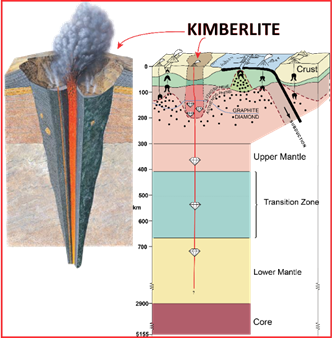Understanding the Deep Earth
Despite the miraculous feats you may have seen in movies such as ‘Journey to the Center of the Earth’ or ‘The Core’, accessing the interior of our planet is presently impossible given the extreme temperatures and pressures any probe (or person) would experience. In fact, the deepest hole on Earth (Kola Superdeep Borehole, Russia) only reaches to 12 kilometres depth at a diameter of just 9 inches. With these difficulties in mind we must find other ways to understand the processes occurring inside the interior of our planet. In my case, that is through interrogating the geochemistry of rare, but valuable, rocks.

(We can’t actually reach the centre of the Earth, yet…)
My name is Hayden Dalton and I am in the 2nd year of studying towards my PhD with the School of Earth Sciences at the University of Melbourne. My PhD research is focussed on kimberlites, a type of igneous volcanic rock. These rocks are unique as they are the ‘conveyor belt’ that carries diamonds from great depths, to the surface of the earth. Indeed, these are the principal host rocks to diamonds and the deepest derived magmas on Earth, originating from depths greater than 200 km before erupting through the crust. As well as diamonds, kimberlites also carry fragments of the mantle as part of their cargo, called xenoliths. Because of their super-deep origins, we can use kimberlites and their deeply-derived diamond and xenolith load as a ‘window’ through which we can examine the evolution of the Earth’s mantle.

(Kimberlites are believed to originate from depths of up to 700 km inside the Earth’s mantle)
The kimberlites I am researching originate from Finland, a region of the world not typically associated with these rocks (compared to southern Africa and Canada). One of the early highlights of my research is that I have been able to utilise radiogenic isotopes (a set of elements which undergo radioactive decay) to work out the source of these rocks but also when they were erupted to surface – in this case I have discovered that these kimberlites were erupted 700,000,000 years ago. Another highlight was attending the International Kimberlite Conference in Botswana where our group (Kimberlites and Diamonds Research Group) were fortunate enough to have discussions with the pre-eminent researchers in this field while also being able to explore a beautiful part of southern Africa.

(Giving a presentation on the geochemistry of kimberlites from Finland at an international conference was a great experience!)
As my PhD progresses I aim to understand how and why these rock types erupt in such localised pockets of the Earth and learn more about the structure of the mantle in these parts of the globe. In addition, this may also reveal why such rocks are so incredibly rare; for example, the last kimberlite eruption on Earth was over 12,000 years ago, compare that to Hawaii where eruptions occur almost yearly. So, while we can’t yet walk into the Earth’s mantle, I am fortunate enough to be employing novel and precise geochemical analytical techniques within the Isotope Geoscience facility in the School of Earth Sciences that will reveal new insights into this presently inaccessible realm of the planet.